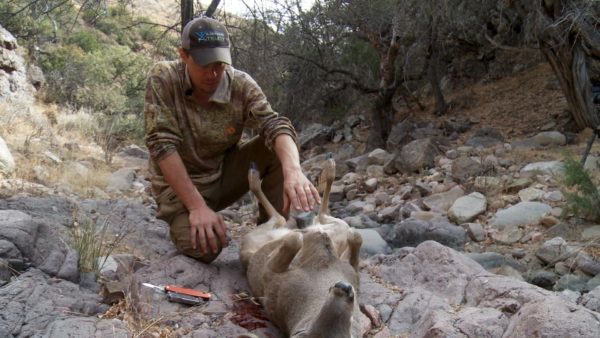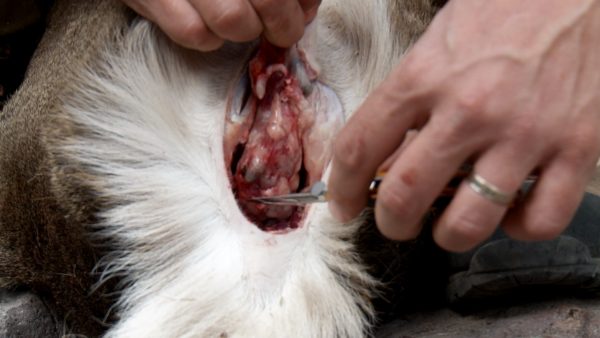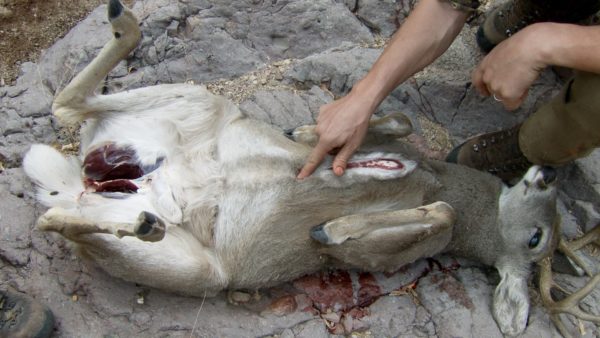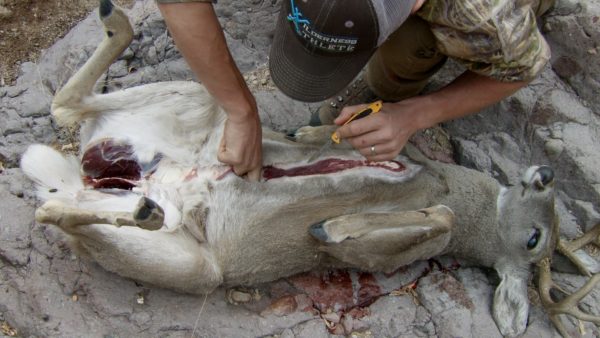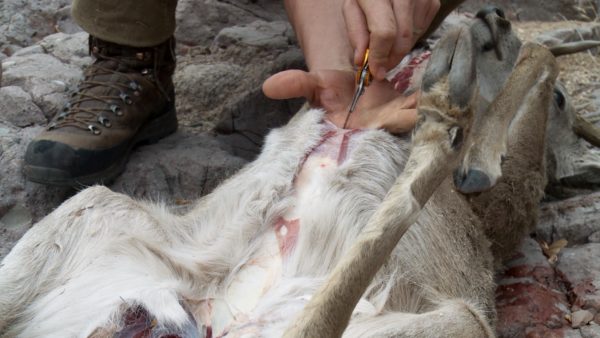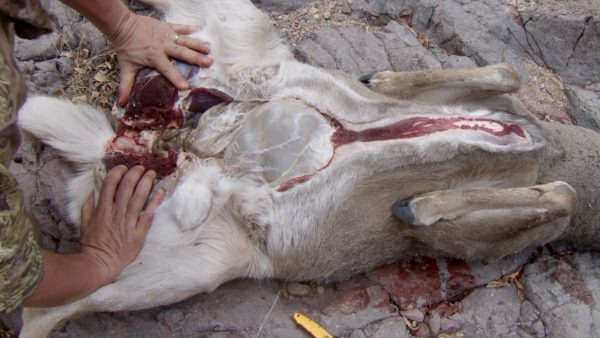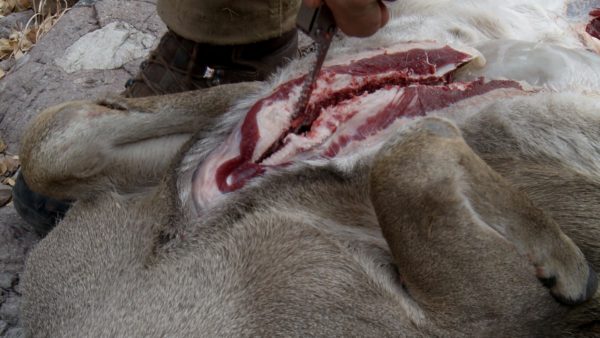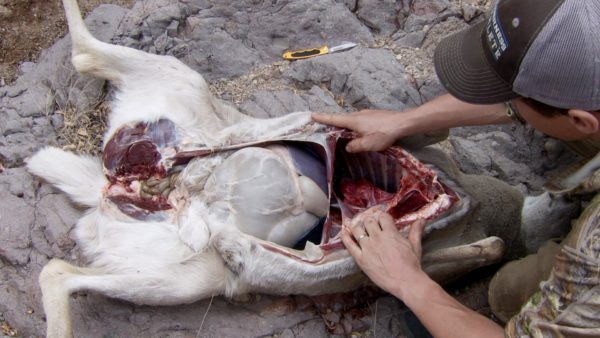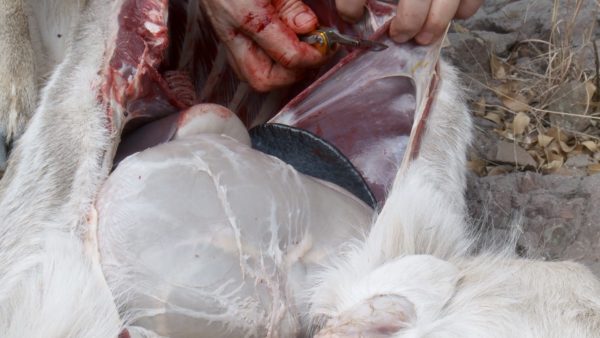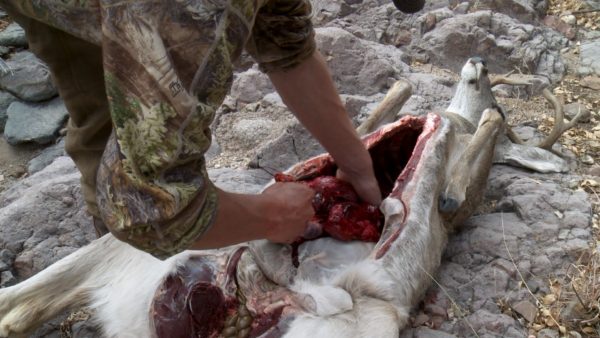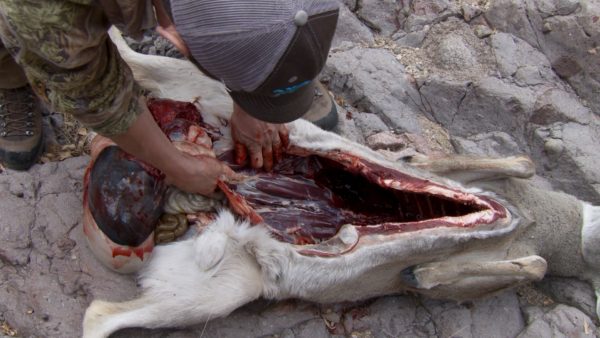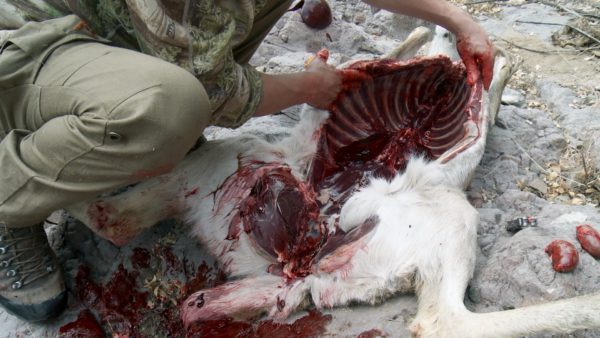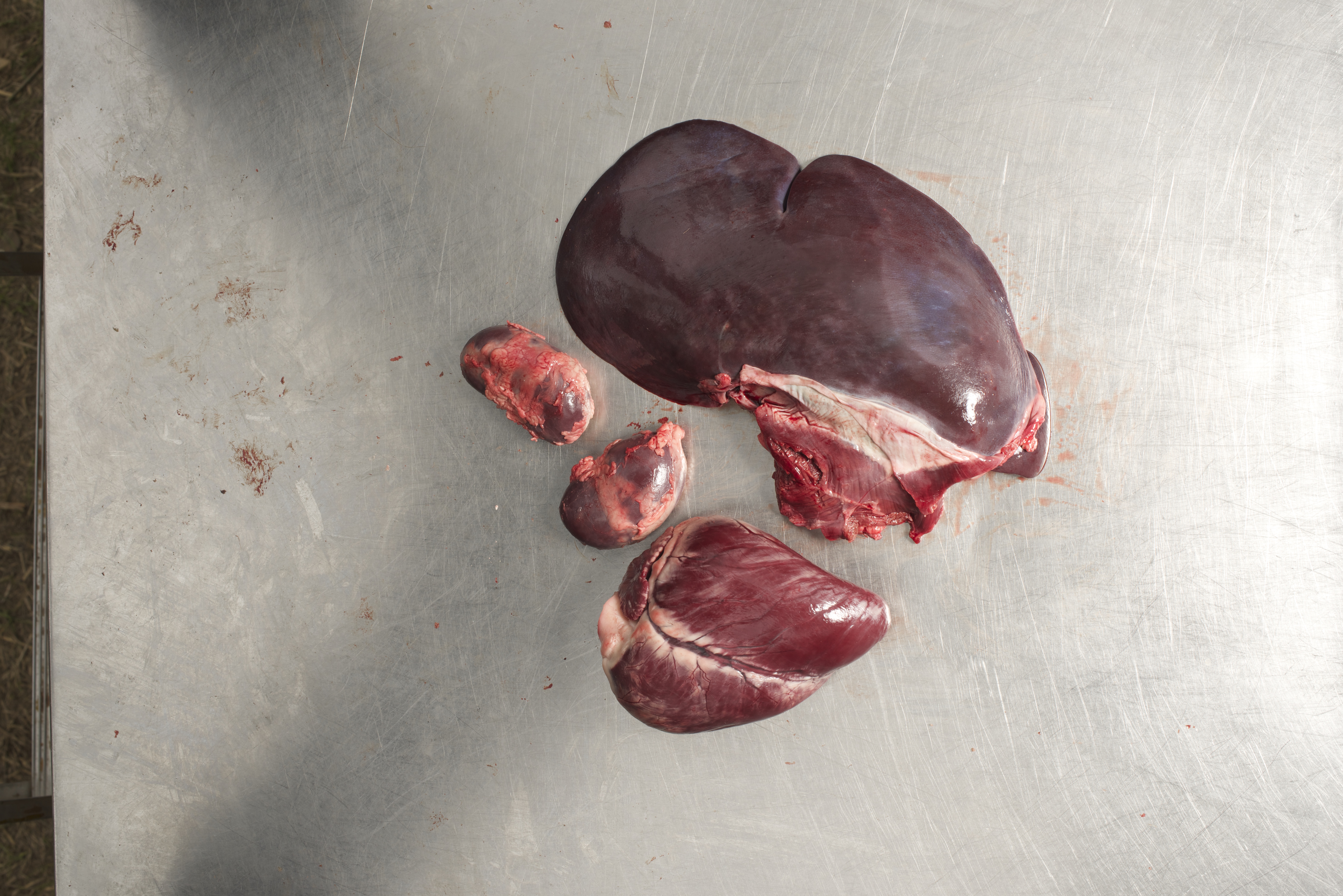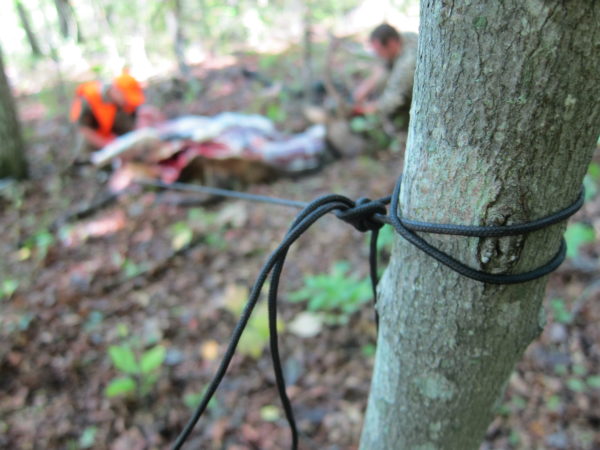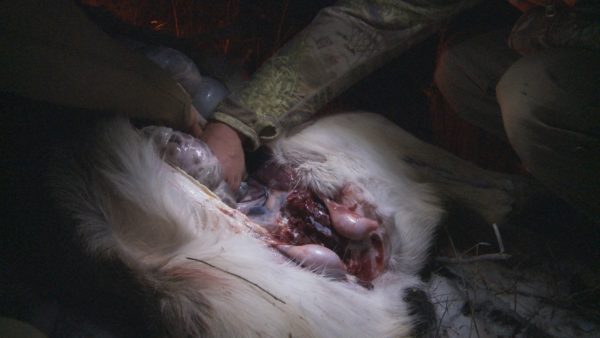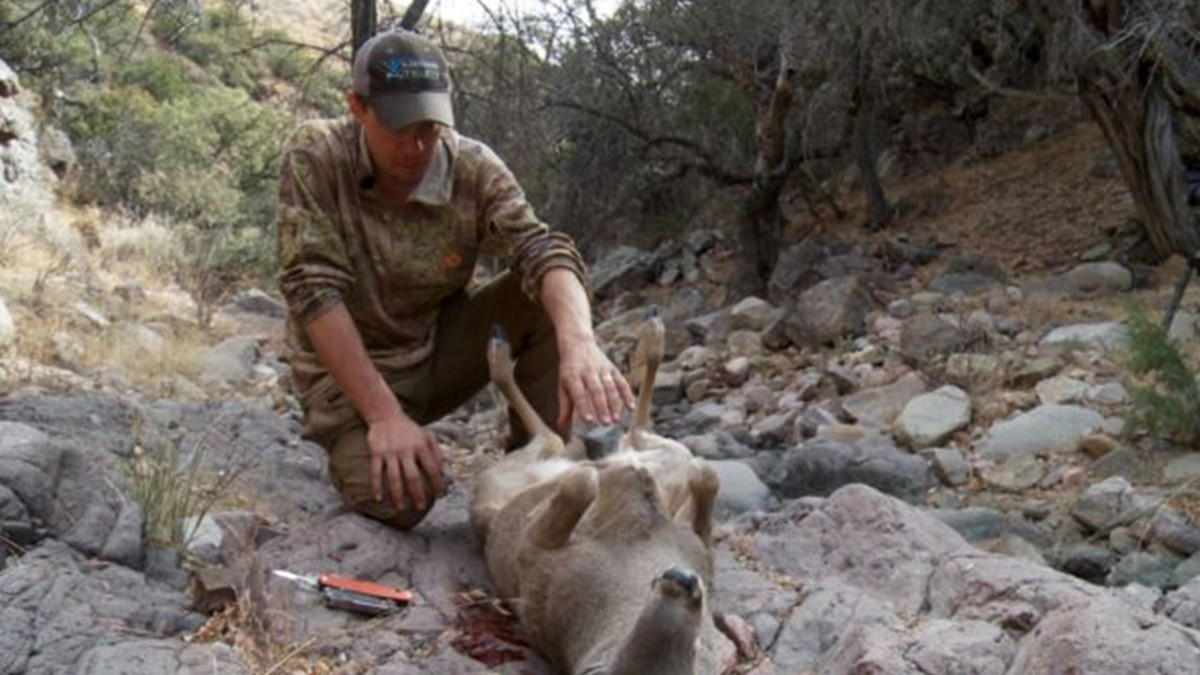
The work of hunting does not end with a kill. In some respects, it’s only just begun. You owe it to the animal, and to yourself, to make sure that the carcass is handled as carefully as possible to ensure quality meat. Regardless of whether the animal will be skinned and processed in the field or at home, it needs to be gutted immediately.
Big game should be gutted as soon as possible, preferably within an hour of the animal’s death. All big game animals are gutted in essentially the same way, though there are obvious differences in the matter of scale. The sequence of the following steps is not entirely rigid, and there are many shortcuts that can speed the process along.
The following step-by-step procedure is meant to give you a full understanding of the work involved. Once you gain some proficiency, you will develop your own favorite way of going about it.
Start by positioning the animal on its back, with the spine as straight as possible and the legs pointing toward the sky.
Cut through the skin around the animal’s anus, leaving the anus connected only to the colon. Use the tip of your knife to free the connective tissues that hold the animal’s colon in place. Get in there as far as possible. The colon should be lying inside the pelvis like the end of a hose, totally freed up.
Starting at the top of the anus incision, slice upward through the hide to a point just past the animal’s pelvis – DO NOT cut through the abdominal wall. Slice down through the muscle until you hit the pelvis bone. On males, cut down on each side of the pelvic ridge. On females, you can make just one slice down to the bone. Note: if you’re going to be dragging the animal any appreciable distance, you can omit this step. By leaving this area intact, it’s easier to keep the meat clean during transportation. The downside is that the animal does not cool as quickly, and this is a part of the carcass that’s vulnerable to spoilage in warm weather.
Go up to the point of the animal’s brisket and start an incision through the hide. Run this incision all the way down the animal’s underside until it meets the opening you created in order to expose the pelvis bone. Be careful not to knick the muscle beneath the hide, as you might puncture the internal organs as well.
At this point you’re ready to cut through the abdominal wall. The safest place to enter the abdomen is at the very bottom of the rib cage. Make a very shallow and careful cut through the abdominal muscles, just enough to insert your middle and index fingers. With your fingers facing up, lift the abdominal muscles up and away from the stomach and slice through the lining along the same incision that you made through the hide. End the cut at the lower end of the abdomen, where the belly terminates at the pelvis area between the two rear legs.
Reach one hand inside the animal’s pelvis and press the bladder and intestines away from the pelvis bone as you use your other hand to split the pelvis bone with a saw or small hatchet. On males, cut through the bone on each side of the ridge. On females, cut down the middle. Once the bone is cut, forcibly push the rear legs apart. You should now have a clear gateway through which the colon and lower intestine will pass when you pull the guts away from the animal.
Go back to the point of the sternum where you began your incision through the abdominal wall. From there, use a bone saw, hatchet, or heavy knife to split the sternum all the way to the base of the neck. Then forcibly separate the two halves of the rib cage.
Reach into the front of the chest cavity and sever the windpipe. Also slice through the diaphragm, freeing it from the walls of the ribcage on both sides of the animal all the way down to the spine.
Using two hands, reach up to where you severed the windpipe and get a good grip on the package of organs at the top end of the animal. Pulling slowly and firmly, you should be able to walk backward and drag the entire load of guts out of the animal. Keep a knife handy, as you might need to reach in and slice free the diaphragm or connective tissues around the pelvis if things gets hung up.
Go through the gut pile and remove the heart, kidneys, and liver.
A Tip for Handling Large Animals
When handling large animals or working on uneven terrain, you can use lengths of cord to hold rig the animal into whatever position you want. Here, an elk hunter in Kentucky uses a piece of paracord to keep a bull’s back leg out of the way during the skinning job.
Evidence of Sex
Many states require hunters to leave the evidence of sex naturally attached to big game carcasses until the animal reaches its final point of processing. The animal’s head counts as evidence of sex only as long as it’s naturally attached to the carcass.
Once the animal’s head is removed in the process of quartering or butchering in the field, legal evidence of sex in the form of reproductive organs/features must be left naturally attached to the meat. Acceptable evidence of sex usually includes the vulva or mammary glands on females and the testicles on males.
To leave the evidence of sex on a bull or buck:
- After freeing the anus and colon, find the uppermost end of the penis sheath and start skinning and detaching it, hide and all, with the penis inside. You’ll be cutting on both sides of the sheath. (It’s like you’re skinning off a two-inch wide strip of hide from the center of the animal’s belly. When you go to open the animal for gutting, you can use this incision as the starting point for the abdominal gutting incision.
- It is important to note that within the animal’s hide the penis is free from the testicles. So as you continue detaching the penis, nearing the scrotum, the testicles will appear and naturally fall to each side. The testicles are not attached to each other.
- If you have a hunting partner, have him or her hold the testicles out of the way as you continue detaching the penis from the carcass.
- Continue skinning the penis all the way to the anus (yes, it does originate there). At this point you can either cut off the penis at the anus or leave it attached and it will come out with the guts. Both are acceptable.
- At this point the testicles are loosely attached to the hide. Gently, peel the testicles free from the hide. They should now be attached solely to the corresponding rear quarter by the narrow tube of the vas deferens.
- Continue with the gutting procedure, being careful not to disturb the placement and fixture of the testes.
To leave the evidence of sex attached to a cow or doe:
- After cutting the hide from the loosened anus forward to the neck, come back to the location of the udders and mammary. Be prepared, as females with late-born offspring might still have milk in the mammary; some might flow out as you work. (It was common for Plains Indians to lap up the milk that leaked from the mammary glands of female buffalo during the butchering practice.)
- Skin the hide, along with the teets, away from the mammary gland. The gland is connected to the meat only by light connective tissue, so work carefully.
- The gland is rather large, so trim away everything but a chunk measuring about 3” by 3”. The quarter can now be removed from the carcass with the mammary attached.
- Alternatively, you can leave the vulva attached simply by cutting around it and leaving a long tab of skin that connects it to rear ham. It should look as if you neglected to skin a 5” piece of hide away from the rear ham. The only downside of this option is that patch of skin tends to get a lot of hair on the meat during handling. Wrapping a plastic bag around the tab of hide and securing it with a rubber band or zip tie can mitigate this.

